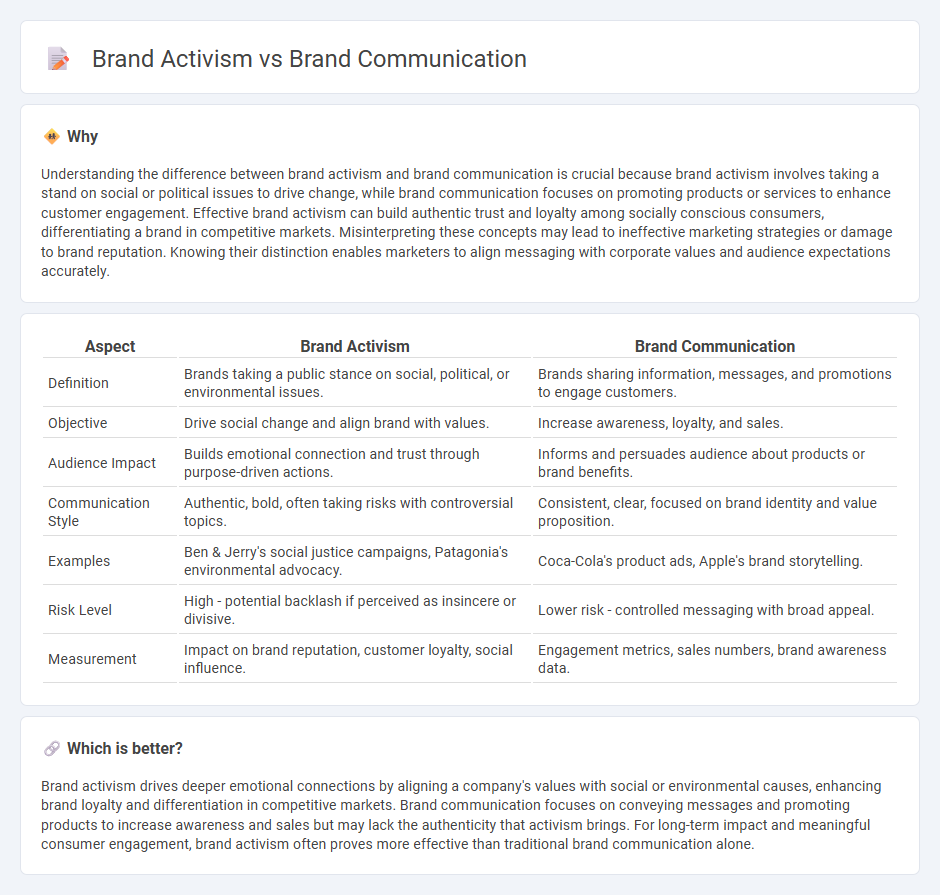
Brand activism involves companies taking a strong stance on social, political, or environmental issues to align their values with those of their consumers, driving loyalty and social impact. Brand communication focuses on conveying a company's messages, values, and offerings to target audiences through strategic marketing channels to build awareness and engagement. Discover more about how these approaches shape modern marketing strategies.
Why it is important
Understanding the difference between brand activism and brand communication is crucial because brand activism involves taking a stand on social or political issues to drive change, while brand communication focuses on promoting products or services to enhance customer engagement. Effective brand activism can build authentic trust and loyalty among socially conscious consumers, differentiating a brand in competitive markets. Misinterpreting these concepts may lead to ineffective marketing strategies or damage to brand reputation. Knowing their distinction enables marketers to align messaging with corporate values and audience expectations accurately.
Comparison Table
| Aspect | Brand Activism | Brand Communication |
|---|---|---|
| Definition | Brands taking a public stance on social, political, or environmental issues. | Brands sharing information, messages, and promotions to engage customers. |
| Objective | Drive social change and align brand with values. | Increase awareness, loyalty, and sales. |
| Audience Impact | Builds emotional connection and trust through purpose-driven actions. | Informs and persuades audience about products or brand benefits. |
| Communication Style | Authentic, bold, often taking risks with controversial topics. | Consistent, clear, focused on brand identity and value proposition. |
| Examples | Ben & Jerry's social justice campaigns, Patagonia's environmental advocacy. | Coca-Cola's product ads, Apple's brand storytelling. |
| Risk Level | High - potential backlash if perceived as insincere or divisive. | Lower risk - controlled messaging with broad appeal. |
| Measurement | Impact on brand reputation, customer loyalty, social influence. | Engagement metrics, sales numbers, brand awareness data. |
Which is better?
Brand activism drives deeper emotional connections by aligning a company's values with social or environmental causes, enhancing brand loyalty and differentiation in competitive markets. Brand communication focuses on conveying messages and promoting products to increase awareness and sales but may lack the authenticity that activism brings. For long-term impact and meaningful consumer engagement, brand activism often proves more effective than traditional brand communication alone.
Connection
Brand activism and brand communication intersect through strategic messaging that reflects a company's values and social commitments, enhancing consumer trust and loyalty. Effective brand communication channels amplify brand activism efforts by engaging audiences with authentic stories and measurable impact, reinforcing the brand's social purpose. This synergy boosts brand equity by aligning corporate actions with customer expectations and societal issues.
Key Terms
**Brand Communication:**
Brand communication involves strategic messaging designed to convey a brand's values, products, and identity to target audiences through various channels like advertising, social media, and public relations. This approach aims to build brand awareness, foster customer loyalty, and differentiate the brand in competitive markets by creating consistent, engaging narratives. Discover how effective brand communication can elevate your business and connect deeper with your audience.
Messaging
Brand communication centers on conveying consistent, clear messages that establish and reinforce a brand's identity and values to build customer loyalty. Brand activism integrates purpose-driven messaging aligned with social or environmental causes, aiming to influence public opinion and foster positive change. Discover how strategic messaging differentiates and connects these approaches in brand storytelling.
Consistency
Brand communication prioritizes consistent messaging across all channels to build trust and reinforce brand identity, ensuring every interaction aligns with core values. Brand activism demands consistent and genuine commitment to social or political causes, as consumers expect authentic actions rather than superficial statements. Explore how maintaining consistency in both strategies enhances brand credibility and consumer loyalty.
Source and External Links
The complete guide to effective brand communication - Mural - Brand communication is about expressing your brand's message, values, and personality consistently across all touchpoints to build trust and long-term relationships with your audience.
Everything You Need to Know About Brand Communication - Brand communication includes tactics like advertising and social media used to shape how customers think about a brand and involves creating a communications plan for consistent, genuine messaging.
Brand Communication: How It Works & Why You Must Perfect It - Piggy - It is a strategic process encompassing every interaction with customers, from online content to customer service, requiring a two-way communication to build brand trust and loyalty.
 dowidth.com
dowidth.com